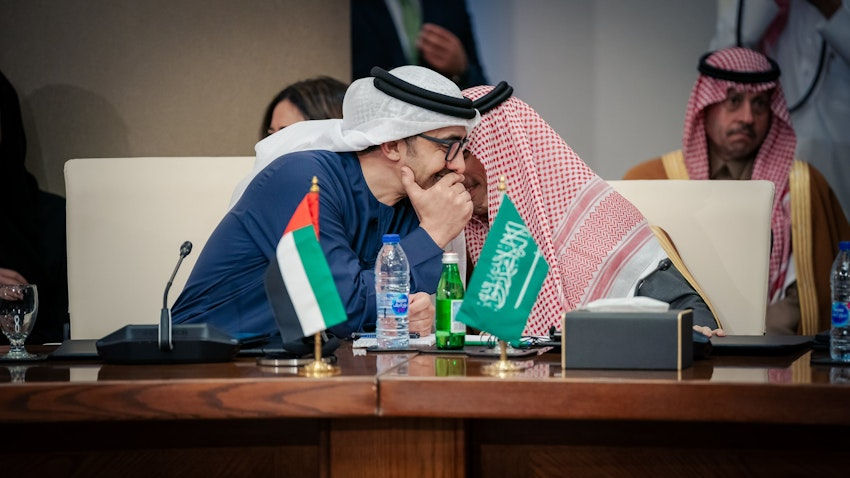Saudi-Qatar reconciliation, from a divisive canal to a railroad connection
- Andreas Krieg
- Jan 12, 2022
- 4 min read
The post-Al Ula Gulf is still characterized by mistrust and suspicion, but what role will joint infrastructure and investment projects play in redefining relationships between the neighbouring countries? [originally published on Doha News]
On Thursday 6 January 2022 the Saudi Minister of Transport met his Qatari counterpart in Doha to discuss plans to connect the kingdom to Qatar via a high-speed rail network – incidentally just a year after Saudi Arabia hosted a GCC summit in Al Ula that marked the beginning of the end of the Gulf Crisis.
While joint railroad plans are indicative of the progress made in bilateral reconciliation it is also quite paradoxical considering that just four years ago Saudi Arabia floated the preposterous idea of digging a canal to physically cut Qatar off from the Arabian Peninsula.
Although rejected as an unfeasible idea by experts early on, the Saudi-linked information operation nonetheless created headlines as the divide between the Gulf neighbours was literally supposed to be cast in the sand. Yet, although not solved, the crisis has now been managed.
The plan to connect the two neighbours via a rail network is more than a decade old.
In 2009 a multilateral railway project was approved at the 30th Gulf Cooperation Council (GCC) summit, which was meant to connect all six member states via a vast infrastructure project – one of many multilateral GCC projects that never saw the light of day.
Instead, in keeping with a wider trend in the post-Al Ula Gulf, it seems that this multilateral project has now been relegated to a bilateral project.
With neo-mercantilist pragmatism taking over from ideological confrontation in the Gulf, joint infrastructure and investment projects in the GCC appear to be now matters of bilateral agreements creating more outsiders than co-beneficiaries.
While the Al Ula summit drew a line under three and a half years of divisive policies and narratives, the relations between Gulf neighbours have not returned to the pre-crisis conciliatory tone.
Although the blockade was lifted and Qatar mended ties with each of the blockading country individually, other sticking points have emerged between Gulf member states.
The competition between the kingdom and the United Arab Emirates (UAE) in particular has increased: over regional leadership, over access to investments and human capital, as well as over unified positions to regional crises such as Yemen or Ethiopia.
Meanwhile, Oman long trying to fend off Emirati and Saudi influence operations, has now put its eggs in the Saudi basket opening up to billions of infrastructure investments from the kingdom, which in turn tries to bypass the over-reliance on the UAE to access the Indian Ocean.
And the vision of a GCC customs union is dead as competition over national free zone access becomes ever more zero-sum.
The post-Al Ula Gulf is still characterized by mistrust and suspicion. For Qatar much of the Gulf Crisis was personal as Saudi and Emirati-linked information operations targeted senior members of Qatar’s royal family.
The rest was ideological with very little on the surface of the crisis being actually issue-based. It is therefore not surprising that Qatar is treading lightly in their rapprochement with its neighbours, even when it comes to Saudi Arabia where progress in the reconciliation has been most tangible.
Both sides have pragmatically steered away from touchy subjects to concentrate on areas of mutual interest. Saudi grievances over Al Jazeera’s reporting, over Qatar’s support for civil society in the region and over Doha’s opposition to authoritarianism, have so far not been addressed.
The ideological elements of the Gulf Crisis have been frozen as at least Saudi state-sponsored information operations against Qatar have disappeared over the past year.
Instead, both sides have focused upon pragmatic bilateralism ignoring the various multilateral issues the GCC has been unable to deal with for years. Closer socio-cultural links between the kingdom and Qatar made it easier for both sides to ignore ideological and personal differences than it was for Qatar and the UAE.
Doha also finds it more natural to support Riyadh’s ambition of regional leadership in face of Abu Dhabi unilateralism vis-à-vis Israel, Syria and Turkey.
More important than that however, is the fact that bilateral neo-mercantilism in the region has become the means of choice to forge relationships – a model Abu Dhabi has been effectively employing in the region for decades.
Mutually beneficial infrastructure investments tie down neighbours in joint projects for years, sometimes decades, decreasing the propensity of both sides to fallout.
Like with Oman, where the kingdom has co-invested into a 725-km highway bypassing the UAE, the Saudi-Qatari railway project has the potential to bring the kingdom and Qatar closer together.
It provides opportunities for the private sector as well to benefit from large state investments on both sides of the border – something that is extremely important for Saudi Crown Prince Mohammad bin Salman (MbS) who is eager to push private sector growth.
Nonetheless, even though sober and pragmatic neo-mercantilism offers great potential for pan-GCC multilateralism, it appears as if the future of the Gulf at least for the moment is founded on bilateral arrangements.
As the least common denominator among the neighbours is shrinkingly small, the six GCC members will continue to opt out from multilateral projects providing more room for unilateralism and bilateralism.
Ironically, in 2017 it was the alleged inability of Qatar to tow a multilateral GCC line that Saudi Arabia and the UAE cited as the reason to impose the blockade.






Comments